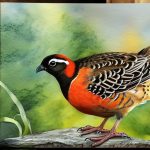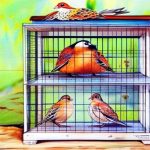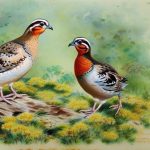King quails, also known as button quails, are small ground-dwelling birds that are native to Australia and surrounding regions. They are popular among aviculturists for their small size, colorful plumage, and interesting behaviors. King quails are known for their distinctive call, which sounds like a series of whistles and chirps. They are also known for their secretive nature, often hiding in dense vegetation to avoid predators.
In the wild, king quails are found in a variety of habitats, including grasslands, woodlands, and scrublands. They are ground-dwelling birds, spending most of their time foraging for seeds, insects, and small invertebrates. In captivity, king quails require a similar diet, consisting of a high-quality game bird feed supplemented with fresh fruits and vegetables. They also require a spacious enclosure with plenty of hiding spots and vegetation to mimic their natural habitat.
King quails are known for their monogamous mating behavior, with pairs forming strong bonds that can last for several breeding seasons. They are also prolific breeders, with females capable of laying a large number of eggs throughout the breeding season. Understanding the natural behaviors and habitat requirements of king quails is essential for successfully breeding and caring for these fascinating birds.
Key Takeaways
- King quails are small, ground-dwelling birds native to Australia and are popular for their colorful plumage and pleasant calls.
- The breeding environment for king quails should include a spacious cage with nesting boxes, suitable bedding, and a balanced diet of seeds, greens, and insects.
- When selecting breeding pairs, it is important to choose healthy, unrelated birds with vibrant plumage and good temperament.
- The breeding and incubation process involves providing a suitable nesting area, collecting and storing eggs, and maintaining optimal temperature and humidity levels for successful hatching.
- Caring for king quail chicks involves providing a warm, safe environment, feeding them a high-protein diet, and monitoring their health and development closely.
- Common breeding challenges for king quails include egg binding, infertility, and predation, which can be managed through proper nesting materials, dietary supplements, and predator-proofing the breeding area.
- Tips for successful king quail breeding include regular health checks, providing a varied diet, and ensuring a stress-free environment for the breeding pairs.
Setting up the Breeding Environment
Creating the right breeding environment is crucial for successful king quail breeding. The first step is to provide a spacious enclosure that allows the birds to exhibit their natural behaviors. A large aviary with plenty of ground cover, such as grass or leaf litter, is ideal for king quails. The enclosure should also include plenty of hiding spots and vegetation to provide security and privacy for the birds.
In addition to a suitable enclosure, it’s important to provide the right nesting materials for king quails. These birds prefer to nest on the ground, so providing a shallow tray filled with clean, dry sand or peat moss can encourage them to build a nest and lay their eggs. It’s also important to provide a variety of natural materials, such as twigs, leaves, and grass, for the birds to use in constructing their nests.
Maintaining the right environmental conditions is also important for successful breeding. King quails require a stable temperature between 65-75 degrees Fahrenheit and a relative humidity of around 60-70%. Providing a consistent day-night cycle with 12-14 hours of daylight can also help stimulate breeding behavior in these birds. By creating a suitable breeding environment, aviculturists can encourage king quails to exhibit their natural mating behaviors and successfully breed in captivity.
Selecting Breeding Pairs
Selecting the right breeding pairs is essential for successful king quail breeding. When choosing breeding pairs, it’s important to consider the birds’ age, health, and genetic diversity. Young, healthy birds are more likely to successfully breed and raise healthy chicks. It’s also important to avoid inbreeding by selecting pairs that are not closely related.
Observing the birds’ behavior can also help in selecting compatible breeding pairs. King quails that are seen preening each other, engaging in courtship displays, and staying close together are likely to form a strong bond and successfully breed. It’s also important to observe the birds’ overall health and condition, looking for signs of illness or injury that could affect their ability to breed.
In addition to behavioral and health considerations, it’s important to consider genetic diversity when selecting breeding pairs. Pairing birds with diverse genetic backgrounds can help maintain healthy populations and reduce the risk of genetic disorders. By carefully selecting breeding pairs based on age, health, behavior, and genetic diversity, aviculturists can increase the likelihood of successful breeding and produce healthy offspring.
Breeding and Incubation Process
Once the breeding pairs have been selected and placed in a suitable breeding environment, the breeding and incubation process can begin. King quails are prolific breeders, with females capable of laying a large number of eggs throughout the breeding season. The eggs are typically laid in the nesting material provided in the enclosure, and the female will continue to lay eggs over a period of several days.
After the eggs have been laid, it’s important to monitor the nest closely to ensure that the eggs are being properly incubated. If the female is not consistently sitting on the eggs, it may be necessary to remove them and place them in an artificial incubator. The eggs should be kept at a stable temperature between 99-100 degrees Fahrenheit and a relative humidity of around 40-50% for successful incubation.
The incubation period for king quail eggs is approximately 16-18 days, after which the chicks will begin to hatch. It’s important to provide a warm, dry brooder for the chicks to ensure their survival during the critical early days of life. The chicks should be provided with a high-protein game bird starter feed and access to clean water to support their growth and development. By carefully monitoring the breeding and incubation process and providing proper care for the chicks, aviculturists can increase the likelihood of successfully raising healthy king quail chicks.
Caring for Chicks
Caring for king quail chicks requires careful attention to their dietary and environmental needs. Newly hatched chicks are small and fragile, requiring a warm, dry brooder with access to food and water. A commercial game bird starter feed with at least 24% protein is recommended for feeding young king quail chicks. The feed should be finely ground or crumbled to make it easier for the chicks to eat.
In addition to providing the right diet, it’s important to maintain the right environmental conditions for the chicks. A stable temperature between 95-100 degrees Fahrenheit should be maintained in the brooder during the first week of life, gradually decreasing by 5 degrees each week until reaching room temperature. The brooder should also be kept clean and dry to prevent disease and ensure the chicks’ health.
As the chicks grow, they can be transitioned to a larger enclosure with access to natural substrate and vegetation. Providing plenty of hiding spots and enrichment items can help stimulate natural behaviors and promote healthy development in young king quails. By providing proper care and attention to the dietary and environmental needs of king quail chicks, aviculturists can increase the likelihood of raising healthy, thriving birds.
Common Breeding Challenges

While king quails are prolific breeders, there are several common challenges that aviculturists may encounter during the breeding process. One common challenge is egg binding, where a female is unable to lay her eggs due to various health issues or improper diet. This condition can be life-threatening if not addressed promptly, so it’s important to monitor the females closely for any signs of distress or difficulty laying eggs.
Another common challenge is infertility or low hatch rates, which can be caused by various factors such as age, genetics, or environmental conditions. It’s important to carefully monitor breeding pairs and make adjustments as needed to improve fertility rates and hatch success. Providing a balanced diet, suitable nesting materials, and proper environmental conditions can help address these challenges and improve breeding outcomes.
Disease and parasites can also pose a threat to breeding king quails. It’s important to maintain a clean environment and monitor the birds for any signs of illness or infestation. Regular veterinary check-ups and preventative measures such as parasite control can help reduce the risk of disease outbreaks and ensure the health of breeding king quails.
Tips for Successful King Quail Breeding
To increase the likelihood of successful king quail breeding, there are several tips that aviculturists can follow. Providing a spacious enclosure with plenty of hiding spots and natural vegetation can encourage natural mating behaviors and nesting activities in king quails. It’s also important to maintain stable environmental conditions with suitable temperature and humidity levels for successful breeding.
Careful selection of breeding pairs based on age, health, behavior, and genetic diversity can increase the likelihood of successful breeding outcomes. Monitoring the birds closely during the breeding process and providing proper care for eggs and chicks can help ensure their survival and healthy development.
Regular veterinary check-ups and preventative measures such as parasite control can help reduce the risk of disease outbreaks and ensure the health of breeding king quails. By following these tips and providing proper care and attention to the needs of king quails, aviculturists can increase the likelihood of successful breeding outcomes and produce healthy offspring.
If you’re interested in king quail breeding, you may also want to explore the article on creating a garden chicken coop on PoultryWizard. This article provides valuable insights into creating a suitable environment for your quails and other poultry, ensuring their well-being and successful breeding.
FAQs
What is king quail breeding?
King quail breeding refers to the process of mating and raising king quails in captivity for the purpose of producing offspring.
What are some tips for successful king quail breeding?
Some tips for successful king quail breeding include providing a suitable breeding environment with proper nesting materials, ensuring a balanced diet for the quails, and monitoring their behavior for signs of mating and egg-laying.
How long does it take for king quails to breed?
King quails typically reach sexual maturity at around 8-10 weeks of age, and breeding can occur throughout the year. Once mating occurs, the female quail will lay eggs within 2-3 weeks.
What should I consider before breeding king quails?
Before breeding king quails, it is important to consider the space and resources needed to care for the offspring, as well as the potential for finding suitable homes for the young quails. Additionally, it is important to ensure that the breeding pair is healthy and free from any genetic or health issues.
Are there any legal considerations for breeding king quails?
In some regions, there may be regulations or permits required for breeding and selling king quails. It is important to research and comply with any legal requirements before engaging in breeding activities.
Meet Walter, the feathered-friend fanatic of Florida! Nestled in the sunshine state, Walter struts through life with his feathered companions, clucking his way to happiness. With a coop that’s fancier than a five-star hotel, he’s the Don Juan of the chicken world. When he’s not teaching his hens to do the cha-cha, you’ll find him in a heated debate with his prized rooster, Sir Clucks-a-Lot. Walter’s poultry passion is no yolk; he’s the sunny-side-up guy you never knew you needed in your flock of friends!







